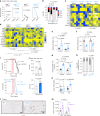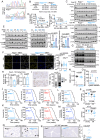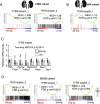A mild increase in nutrient signaling to mTORC1 in mice leads to parenchymal damage, myeloid inflammation and shortened lifespan
- PMID: 38849535
- PMCID: PMC11333293
- DOI: 10.1038/s43587-024-00635-x
A mild increase in nutrient signaling to mTORC1 in mice leads to parenchymal damage, myeloid inflammation and shortened lifespan
Abstract
The mechanistic target of rapamycin complex 1 controls cellular anabolism in response to growth factor signaling and to nutrient sufficiency signaled through the Rag GTPases. Inhibition of mTOR reproducibly extends longevity across eukaryotes. Here we report that mice that endogenously express active mutant variants of RagC exhibit multiple features of parenchymal damage that include senescence, expression of inflammatory molecules, increased myeloid inflammation with extensive features of inflammaging and a ~30% reduction in lifespan. Through bone marrow transplantation experiments, we show that myeloid cells are abnormally activated by signals emanating from dysfunctional RagC-mutant parenchyma, causing neutrophil extravasation that inflicts additional inflammatory damage. Therapeutic suppression of myeloid inflammation in aged RagC-mutant mice attenuates parenchymal damage and extends survival. Together, our findings link mildly increased nutrient signaling to limited lifespan in mammals, and support a two-component process of parenchymal damage and myeloid inflammation that together precipitate a time-dependent organ deterioration that limits longevity.
© 2024. The Author(s).
Conflict of interest statement
The authors declare no competing interests.
Figures














References
-
- Suzman, R. & Beard, J. Global Health and Aging (World Health Organization, 2011).
MeSH terms
Substances
Grants and funding
- ERC-2014-STG-638891/EC | EU Framework Programme for Research and Innovation H2020 | H2020 Priority Excellent Science | H2020 European Research Council (H2020 Excellent Science - European Research Council)
- LCF/PR/HR21/0046/"la Caixa" Foundation (Caixa Foundation)
- ID 100010434 LCF/BQ/DR19/11740022/"la Caixa" Foundation (Caixa Foundation)
- LABAE16001EFEY/AECC/Fundación Científica Asociación Española Contra el Cáncer (Scientific Foundation, Spanish Association Against Cancer)
LinkOut - more resources
Full Text Sources
Molecular Biology Databases
Miscellaneous

